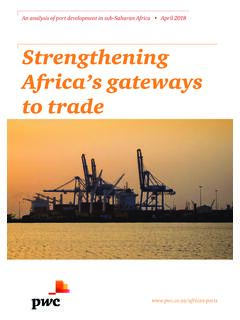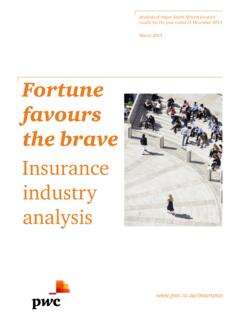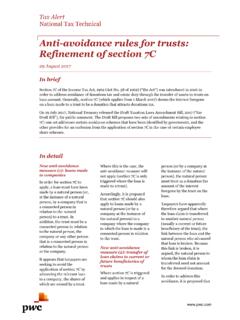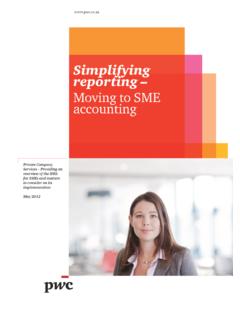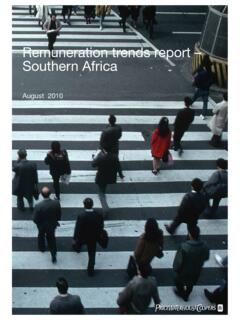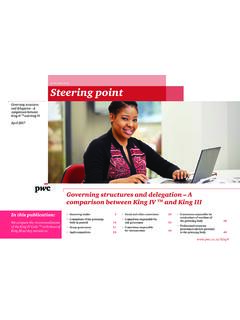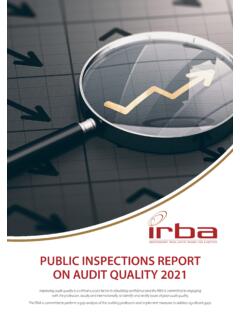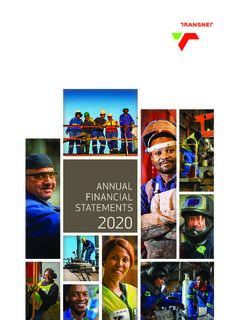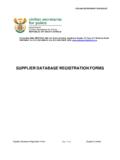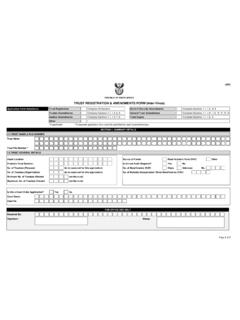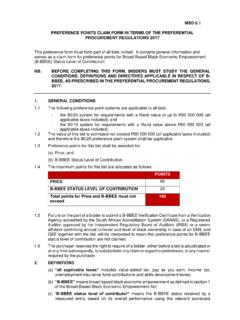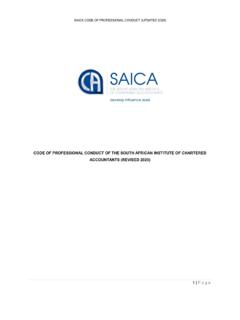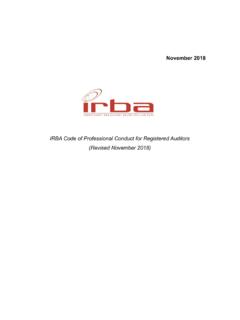Transcription of Understanding mandatory audit firm rotation in South ... - PwC
1 July 2017 Understanding mandatory audit firm rotation in South June 2017, the Independent Regulatory Board for Auditors (IRBA) issued a rule prescribing that auditors of public interest entities (PIEs) in South Africa (SA) must comply with mandatory audit firm rotation (MAFR) with effect from 1 April document sets out the key elements of the new rule as it relates to audit firm rotation , and explores some of the questions that arise based on our Understanding of the requirements at the time of writing. Each organisation is unique and some audit committees may decide to take action in advance of the deadlines imposed by the rule. In making this decision, audit committees may wish to consider how MAFR interacts with other regulations such as lead audit partner rotation and the prohibition on auditors to provide certain non- audit services.
2 Some PIEs may also have very limited experience when it comes to running an audit tender or evaluating auditor transition plans. PwC can assist you as you navigate these and other challenges around MAFR. Please consult with your usual PwC contact to discuss your particular situation further, or reach out directly to any of the PwC experts included on page 7. ForewordPwC | 1 ContentsWhat are the basic requirements for rotation ? 2 When will the new rules be implemented? 2 Who does the new rule apply to? 2 What are the transitional provisions? 3 How does the rule compare to the EU regulations? 3 What is the impact on multinational groups? 4 Applying the rule 4 Keeping informed 7 PwC contacts 72 | audit firm rotation in South AfricaWhat are the basic requirements for rotation ?
3 The new rule on rotation requires that all SA PIEs must rotate their audit firms (including a network firm) after a period of maximum audit tenure. This tenure is set at ten consecutive financial years, after which an audit firm will only be eligible for reappointment as the auditor after the expiry of at least five financial will the new rules be implemented?The rules on mandatory firm rotation are contained within an overarching rule which was published on 2 June 2017 and is effective for financial years commencing on or after 1 April 2023. Who does the new rule apply to?The rule applies to all South African PIEs, including:a. All listed entities; andb. Any entity:i. defined by regulation or legislation as a public interest entity; orii.
4 For which an audit is required by regulation or legislation, to be conducted in compliance with the same independence requirements that apply to the auditing of listed entities. Such regulation may be promulgated by any relevant regulator, including an audit firms are encouraged to determine whether to treat additional entities, or certain categories of entities, as PIEs because they have a large number and wide range of stakeholders. The following entities will generally satisfy this condition and thus are likely to be considered as public interest entities: Major public entities (as listed in Schedule 2 to the Public Finance Management Act as published ) that directly or indirectly provide essential or strategic services or hold strategic assets for the benefit of the country; Banks as defined in the Banks Act 1990 (Act No.)
5 94 of 1990) and mutual banks as defined in the Mutual Bank Act 1993 (Act No. 124 of 1993); Market infrastructure as defined in the Financial Markets Act 2012 (Act No. 19 of 2012). This includes: A licensed central securities depository A licensed clearing house A licensed exchange, and A licensed trade repository Insurers registered under the Long-term Insurance Act 1998 (Act No. 52 of 1998) and the Short-term Insurance Act 1998 (Act No. 53 of 1998), excluding micro lenders; A portfolio within a collective investment scheme, including hedge funds, in terms of the Collective Investment Schemes Control Act, 2002 (Act No. 45 of 2002) that holds assets in excess of R15 billion; Funds as defined in the Pension Funds Act 1956 (Act No.
6 24 of 1956) that hold or are otherwise responsible for safeguarding client assets in excess of R10 billion; Pension fund administrators (in terms of section 13B of the Pension Funds Act 1956 (Act No. 24 of 1956)) with total assets under administration in excess of R20 billion; Financial services providers as defined in the Financial Advisory and Intermediary Services Act 2002 (Act No. 37 of 2002) with assets under management in excess of R50 billion; Medical schemes as defined in the Medical Schemes Act, 1998 (Act No. 131 of 1998) that are open to the public (commonly referred to as open medical schemes ) or are restricted schemes with a large number of members;The definition of a PIE is very broad and extends beyond listed companiesPwC | 3 What are the transitional provisions?
7 Authorised users of an exchange as defined in the Financial Markets Act, 2012 (Act No. 19 of 2012) who hold or are otherwise responsible for safeguarding client assets in excess of R10 billion; and Other issuers of debt and equity instruments to the public. There is no exemption from the rules for organisations that are SA PIEs, but owned or domiciled outside of SA (for example banking subsidiaries of non-SA groups or foreign entities that are listed in SA). However, it s important to remember that the rotation rules apply to the SA PIE only and not to any of its affiliated companies (unless they qualify as a SA PIE in their own right).Furthermore, audit firms may rebut the presumption that an individual entity is a PIE if is not considered to have a large number or wide range of stakeholders ( a bank branch with limited customers and no retail operations).
8 So it will be important for an organisation to clarify this classification with its are limited transitional provisions in the rule the date of rotation is determined by measuring the time for which an audit firm has been the auditor of the PIE as at the start of the first financial year commencing on or after 1 April 2023. If, at the effective date, the PIE has appointed joint auditors and both have had an audit tenure of ten years or more, then only one audit firm is required to rotate at the effective date and the remaining audit firm will be granted an additional two years before rotation is required. There is no guidance as to how the sequence of rotation should occur audit committees and audit firms will need to engage early enough to reach agreement on this are also no transitional arrangements in the year that an organisation first becomes a PIE when the auditor determines that an audit client becomes a PIE, the length of time for which the audit firm has served as auditor before the client became a PIE will be included in determining the timing of audit firm rotation .
9 How does the rule compare to the EU regulations?One of the more recent territories to implement audit firm rotation is the European Union (EU). Here we provide a high-level comparison of a few of the most notable differences between the rule in SA and the EU regulations. In many instances, the rule in SA may be perceived to be more onerous than the EU AfricaEUApplicabilityAll public interest entities. The scope of this definition in South Africa is broader than in the EU PIEs. These are defined as: Entities governed by the law of an EU member state, with transferable securities listed on an EU-regulated exchange (entities incorporated outside of the EU would therefore not be caught by this part of the regulation); Credit institutions; Insurance undertakings.
10 And Entities designation by an EU member state as a periodTen years, with a number of member state options, including the ability to extend audit firm tenure to 20 years if a competitive tender is held at the ten-year of becoming a PIEA udit tenure is counted historically up to the point of the entity becoming a PIE ( if audit tenure is ten years or more at the point of its becoming a PIE, rotation will be required immediately). audit tenure is counted only from the point of the entity becoming a PIE ( if audit tenure is ten years or more at the point of its becoming a PIE, the entity may still keep its incumbent auditor for another ten years).ReappointmentAfter audit firm rotation , five financial years must pass before the same audit firm can be appointed audit firm rotation , four years must pass before the same audit firm can be appointed provisionsLimited transitional provisions (primarily related to joint audits).
